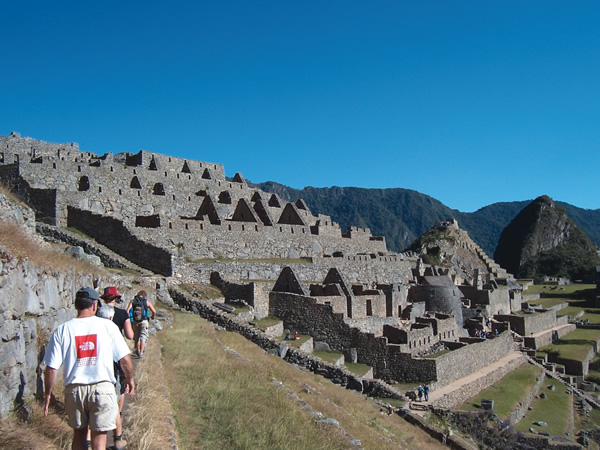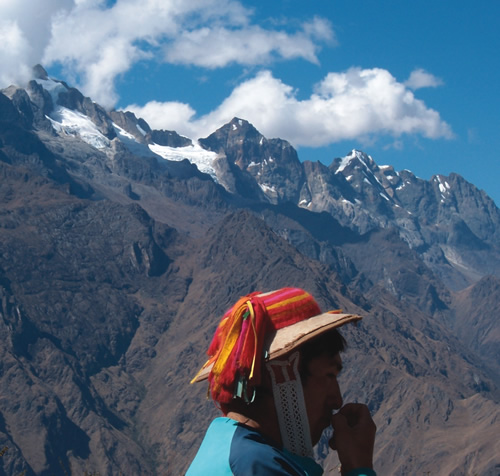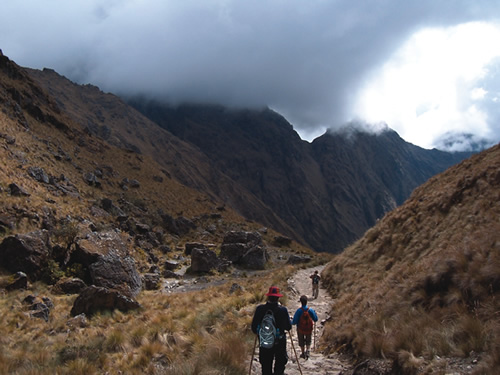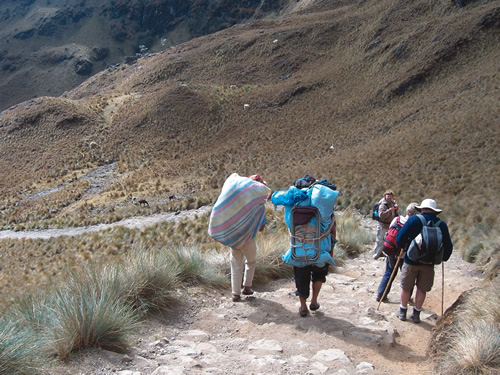Saving Machu Picchu and Peru
Responsible Tourism Is a 3-Way Deal
Article and Photos by Tim Leffel

Who is responsible for sustainable tourism? The government, the tourism industry, or tourists themselves? All of the above, say progressive tourism operators in Peru, but too many people fail to fulfill their part of the bargain. Government action makes a big difference. However, most of their work is for nothing if the tourists don’t spend their dollars wisely and make responsible decisions.
Mike Weston was traveling to Peru from Britain when he met his future wife. He settled in Cusco and later founded Peru Treks and Adventure, a company that benefits the local communities in the area, both through employment and through community projects. The company pours half its profits back into local assistance and development grants. However, Mike says organizations like his cannot make a difference on their own. “The emphasis cannot be only on the hotels and tour operators. Travelers need to do their homework. They have to bring their business to companies that are doing the right thing and spread the word.”
This has become especially important in the region around Machu Picchu. The site was once a mysterious and hidden set of ruins visited mainly by archeologists and hardcore backpackers. In 1992, only 9,000 tourists visited the ruins all year. By 2019 there were 1,500,000 visitors a year! Machu Picchu was then the most visited site in South America. It reportedly generated millions each year for Peru’s economy. Because of the power of this one attraction, tourism is the second largest industry nationwide, after mining, and the largest industry overall in the Cusco region.
UNESCO continually threatens to put Machu Picchu on its list of World Heritage in Danger sites, a designation meant to encourage swift corrective action. For years there has also been plenty of hand-wringing among archeologists and preservationists. In 2000, the World Monuments Fund (WMF), a conservation group based in New York, added Machu Picchu to its watch list of the 100 most-endangered sites. The group later removed it after the Peruvian government scrapped plans to increase the number of visitors and implemented regulations for the Inca Trail.
(Editor's note: Fortunately for the sustainability of Machu Picchu, the land, culture, and locals in the region, beginning in 2019 tickets must be purchased in advance, with the criteria even more stringent as of 2024, with rules and regulations designed to protect the sacred site. A limit of 4,500 tickets a day may be now purchase online to visit the various areas of Machu Picchu.)
This impressive and enigmatic Inca city was meant to be inaccessible. It lies on a narrow peak wedged into a narrow river valley miles from any areas suitable for large-scale farming. Until it was rediscovered by American archeologist Hiram Bingham in 1911, nobody knew about it apart from a few Andean locals. Even today, the only road in the area is a winding switchback that carries tourists up on a bus from Aguas Calientes town at the base. Visitors must arrive by train at the base of the mountain ($46-plus, one way from Cusco) or do the 4-day Inca Trail hike through the mountains ($300-plus).

Regulating the Inca Trail
The Inca Trail itself has been another source of worry for decades. Until the end of 2000, travelers could just show up and hike the 4-day trail on their own or sign up with an escorted group. The result was overcrowding and erosion, lots of garbage, and rampant exploitation of the porters. Eranjelio Seina Castca, one of the porters on my own Inca Trail trip, had no nostalgia for those days. He had been at this for seven years, and over 600 Inca Trail trips. “There was a lot of misery before the controls started,” he says. “We would have to carry over 50 kilos (110 pounds) and there was never enough food. We had to sleep out in the open, with no tents.”
In January 2001 the government began to regulate the trail and to require permits. Of the 93 tour operators that had sold Inca Trail packages at the time, half were denied permission to continue operating. To meet the new requirements tour operators must use only assigned camp sites with proper toilet facilities; carry all garbage with them; use only propane for fuel (no open fires); provide two guides for groups of more than seven tourists; and limit the amount porters carry to 25 kilos.
In general, conditions are far better for the trekkers, the porters, and the trail itself. Another boost has come from the Inka Porter Project, an NGO that spent close to three years working on behalf of porter rights. The group pressured operators to pay a minimum wage for porters and lobbied to improve their conditions. The project also provided English language and first aid programs to over 400 porters and worked to educate tourists on how to choose a responsible agency.
The agency did its job so well that in mid-2005 it shut itself down. Former press and marketing manager Ann Noon says that it is now up to the trekkers to keep things moving in a positive direction by hiring a tour company based on more than price. “The easiest and least visible place to cut corners is in the pay and treatment of the porters.”
Mike Weston also believes the onus is on the visitors. “It continually amazes me that some travelers don’t even crack a guidebook before they leave. Many seem to spend five minutes — at most — researching a tour company for the Inca Trail.” He notes that his company makes it a requirement that trekkers arrive 72 hours before departure to get acclimatized. “If we didn’t, clueless travelers would show up the night before and then keel over on the trail.”

Transforming the Gateway
Like many “tourist ghetto” areas around the world, Machu Picchu town, the gateway area long known as Aguas Calientes, is a mess. It’s a thrown-together collection of structures with few apparent building regulations. Every space is filled with big signs and mass-produced souvenirs. When guests walk into the stunning Machu Picchu Pueblo Hotel, a fancy ecolodge surrounded by orchids and flitting hummingbirds, they can’t believe they are in the same town.
It was even worse before the mayor finally got some of the revenue from Machu Picchu diverted to his town. Garbage disposal has improved and the hot springs are better maintained. Plenty of problems persist, including less visible ones like sewage treatment, but the pressure from several sides has helped significantly.
Alvaro Bedoya Nadramia is one of the people trying to make a difference in the area by following more sustainable practices. His Rupa Wasi Eco Lodge, in Machu Picchu town, has been light years ahead of other hotels in the area since its start three years ago. “Some people are finally waking up and realizing they need to take care of what they have,” he says. “We do what we can to help this through the municipality, but we also try to give a good example by the way we run our own business.” The hotel is built mainly of wood — a rarity here — and even uses organic soap. Waste is composted and Nadramia tries to recycle everything.
Like most other business owners I talked to in Peru, Nadramia puts a fair chunk of the blame for area problems on travelers themselves. “The biggest impact overall, in terms of waste, comes from plastic. So why do tourists buy four or five plastic bottles of water each day instead of just using the one bottle and purification tablets? What do they think happens to all that plastic out here in this isolated area once they throw it away?”

A Long-Term Plan
Despite the throngs of other visitors, as I wandered around the ruins of Machu Picchu after four days hiking to get there, the experience was both humbling and exciting. Our guide Oscar explained that there is fear the structure is sinking and that the continual bus traffic and growing tourist numbers aren’t helping. Japanese scientists said in 2000 that the area was at high risk for a landslide. “They are studying satellite pictures each month. These wires and marks are helping them to see if this theory is real or if it is just worry,” he said.
Every set of feet has an impact, and the luxury side has stepped up and made a huge difference. The Orient-Express Hotels group runs the Monasterio Hotel in Cusco, the Sanctuary Lodge by the entrance to Macchu Picchu, and the train lines to the site, including the elegant Hiram Bingham coach. “When we started our operations here in 1999 you could smell garbage when you walked around Machu Picchu,” said Joanna Boyen, public relations manager for Orient-Express Hotels. “There was literally a huge dump right outside the ruins and they would just light it on fire now and then.”
After dozens of meetings with various municipal governments and agencies the Orient-Express group worked out a program to haul off the original garbage — 100 cubic tons of it — and cart off new refuse three times per week on the train. The company also replaced the old diesel kitchen at the Sanctuary Lodge with natural gas and installed a water filtration system for both the inflow and outflow.
In addition Orient-Express worked hard to help broker a deal between UNESCO, the World Bank, and the local governments to avert a crisis over Machu Picchu. The parties are drafting a master plan, one that will limit the number of visitors but will also provide investment to deal with garbage, sewage, and Inca Trail maintenance. “It looks like we are going to settle on a daily limit of 2,500 visitors,” says Boyen. “It’s a few hundred people more than we get now on peak days, but tourism in Peru is climbing at the rate of 15 to 20 percent per year, so you have to allow at least a small cushion for growth. This sets a defined stopping point so it doesn’t keep growing exponentially.”
At the same time the admission price will rise again, to $30 per person in the near future. As with any golden goose historical site, the struggle between commerce and preservation brings up all kinds of conflicts. “Who comes to Peru for the first time and doesn’t go to Machu Picchu?” asks Weston. “So if the government wants Peru tourism to increase by 10 percent per year, that means 10 percent more visitors to Machu Picchu, automatically. But it’s already close to capacity now, so what can you do to compensate? You have to raise the price.”
Ann Noon notes that the Inca Trail permit has risen from $17 to $60 per person. “But a fair amount of that money is going into trail maintenance, monitoring of regulations, and better toilets. The free-for-all was cheaper, but sustainable tourism costs money.”
“You can’t pay a rock-bottom price for everything and still expect responsible tourism to magically happen,” says Weston. “If the Inca Trail and Machu Picchu are to be preserved, everyone who goes has to do their part. The only thing that is going to keep tour operators from trying to cut corners is market forces. If companies lose business because they get a bad reputation, they will change. Travelers who don’t do any research and don’t speak up are just reinforcing the bad practices.”
|
